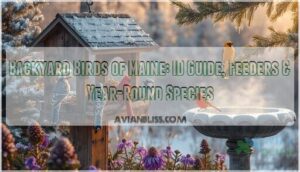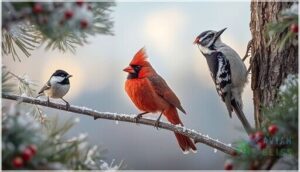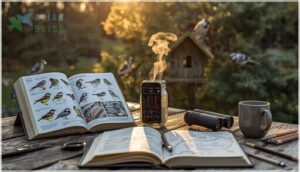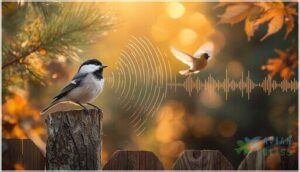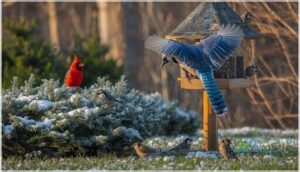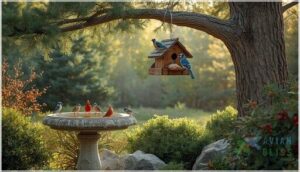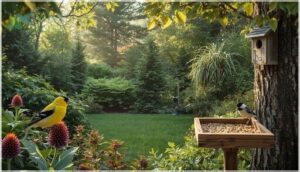This site is supported by our readers. We may earn a commission, at no cost to you, if you purchase through links.
Maine’s backyard feeders host over 200 bird species throughout the year. This makes the state a reliable destination for birdwatchers who prefer their own property to distant trails. The state’s mix of coastal habitats and inland forests creates conditions that support both year-round residents and seasonal migrants.
Your feeder might draw Black-capped Chickadees in January and Baltimore Orioles in May. Understanding which species appear when helps you choose the right feeders and food. You’ll also learn to identify birds by size, plumage, and bill shape.
Native plants and fresh water sources boost the number of species that visit and stay.
Table Of Contents
- Key Takeaways
- Year-Round Backyard Birds of Maine
- Seasonal Backyard Birds in Maine
- Identifying Backyard Birds in Maine
- Attracting Birds to Your Maine Backyard
- Bird Conservation and Backyard Habitat Tips
- Frequently Asked Questions (FAQs)
- How do I identify a bird in my backyard?
- What is the main bird in Maine?
- What is the little GREY bird in Maine?
- What birds stay all winter in Maine?
- How can I attract more hummingbirds to my yard?
- What are some good native plants for butterflies and bees?
- How do I keep squirrels off my bird feeders?
- Are there any birds that eat mosquitoes or ticks?
- How can I help birds during extreme weather events?
- What time of day are birds most active?
- Conclusion
Key Takeaways
- Maine’s backyard feeders attract over 200 bird species year-round, with seven common residents like Black-capped Chickadees and Blue Jays staying through winter while seasonal visitors like American Robins and Dark-eyed Juncos arrive based on temperature and food availability.
- Successful bird identification relies on observing size comparisons, plumage patterns, bill shapes, and behaviors—with tools like field guides and apps like Merlin Bird ID helping confirm species, though learning songs and calls sharpens accuracy beyond visual marks alone.
- You’ll attract more birds by matching feeders to species preferences, offering black oil sunflower seeds that draw 79% of backyard species, maintaining fresh water sources that double visitor numbers, and planting native shrubs like highbush blueberry that boost bird activity by 70%.
- Supporting Maine’s bird populations means participating in citizen science projects like the Great Backyard Bird Count, practicing regular feeder maintenance to prevent disease, and creating safe nesting areas with proper nest box placement and native materials.
Year-Round Backyard Birds of Maine
Maine’s backyard feeders stay busy all winter long with birds that call the state home every month of the year. These hardy species have adapted to the cold and don’t migrate when temperatures drop.
Let’s look at the seven most common year-round birds you’ll spot in your Maine backyard.
Black-capped Chickadee — Maine’s State Bird
The Black-capped Chickadee became Maine’s state bird in 1927. You’ll spot this small bird year-round in your backyard. It measures about five inches long with a distinctive black cap and white cheeks. They’re also known for their enthusiastic singing habits.
- Physical Traits: Short rounded bill and greyish-blue feet
- Food Caching: Remembers storage locations for 28 days
- Winter Survival: Diet includes insects and cached seeds
- Nesting Habits: Uses tree cavities 1-7 meters high
American Crow — Maine’s Most Common Bird
American Crow stands out as Maine’s most frequently observed backyard bird species. You’ll recognize these large coal-black birds by their distinctive “caw” vocalizations and fan-shaped tails.
Crow intelligence shows in their opportunistic diet habits—they’ll eat insects, spiders, and scavenged food. They’re known to be opportunistic feeders, taking advantage of various food sources.
During fall and winter, American Crow populations gather in massive communal roosts for warmth and safety. Their urban adaptation helps them thrive near developed areas throughout Maine.
Blue Jay — Behavior and Identification
Blue Jay stands out among Maine backyard birds with its vivid blue plumage and prominent head crest. These year-round residents measure 22 to 30 cm in length and defend breeding territories aggressively from late March through July. You’ll easily recognize them by their:
- Vibrant blue feathers with white underparts
- Black U-shaped collar around the neck
- Harsh descending jay vocalizations
- Territorial defense behavior during nesting
- Strong beaks for cracking nuts
Their mimicry of hawk calls often scares competitors away.
Downy Woodpecker — Feeder Habits
You’ll spot Downy Woodpeckers visiting your Maine feeders throughout the year, especially during winter when they prefer suet and black oil sunflower seeds.
Males and females split foraging areas in cold months, with males feeding on smaller branches while females work larger trunks. Watch for male competition at prime feeding spots, and you might see adults teaching fledglings proper feeder use.
Northern Cardinal — Song and Plumage
The Northern Cardinal stands out as one of Maine’s most recognizable backyard birds, with males showing vivid red plumage and both sexes singing year-round. You’ll notice these songbirds communicating through distinct calls and colorful displays.
- Males defend territories using 8 to 24 different song dialects
- Female song during nesting helps coordinate mate feeding
- Plumage genetics determine red coloration from dietary carotenoids
Their annual molt timing occurs after breeding season.
White-breasted Nuthatch — Climbing Behavior
In Maine, White-breasted Nuthatches display striking climbing adaptations that set them apart from other backyard birds. You’ll see them moving headfirst down tree trunks, a behavior few North American species can manage. Their strong rear toe provides considerable grip, letting them explore bark crevices that upward-climbing birds miss during foraging.
| Climbing Feature | Function | Benefit |
|---|---|---|
| Three forward toes + strong rear toe | Vertical surface grip | Headfirst descent capability |
| No tail support needed | Independent leg movement | Access to overlooked food sources |
| Downward foraging pattern | Predator evasion | Discover hidden insects in bark crevices |
| Food wedging behavior | Winter caching strategy | Survival during cold months |
| Sequential foot placement | Controlled descent | Efficient bark exploration |
This headfirst foraging technique helps nuthatches find insects and larvae other birds overlook. During winter, they cache seeds in bark fissures, then return to retrieve them using their unique climbing skills for survival.
American Goldfinch — Seasonal Plumage Changes
Throughout each year in Maine, you’ll notice American Goldfinches transform dramatically through a molting process driven by hormonal triggers and dietary influence. Summer plumage features vivid yellow feathers and a black cap on males, while winter camouflage shifts both sexes to drab olive-brown tones.
These seasonal bird sightings illustrate how finch identification changes with the calendar, making plumage and bird identification timing-dependent skills.
Seasonal Backyard Birds in Maine
Maine’s backyard bird scene shifts with the seasons. Some species arrive for the warm months while others show up when snow covers the ground.
Understanding these seasonal patterns helps you know which birds to expect and when they’ll visit your feeders.
Common Summer Birds (American Robin, Common Yellowthroat, Red-winged Blackbird)
When warm weather arrives, you’ll notice a shift in your backyard’s bird activity. American Robins become abundant as robin breeding habits ramp up, with pairs producing 2.5 fledglings per successful nest. Common Yellowthroat territories center within marshy areas, while Red-winged Blackbird population trends show these summer bird species in Maine favoring wetlands.
Summer habitat use and reproductive success peak during these months, transforming backyard birds of Maine into bustling breeding grounds.
Frequent Winter Visitors (Dark-eyed Junco, American Tree Sparrow)
When snow blankets your yard, two winter bird species in Maine arrive to liven things up: Dark-eyed Junco and American Tree Sparrow. Both prefer ground-feeding beneath your feeders, targeting millet and cracked corn.
Winter identification is straightforward—juncos sport slate-gray plumage while Tree Sparrows show rusty caps.
Despite population trends indicating habitat loss and climate impacts, winter bird feeding helps sustain these backyard birds of Maine through harsh months.
Migration Patterns and Arrival Times
Bird migration patterns in your Maine backyard follow a predictable rhythm. Spring arrivals span mid-March through late May, with most species peaking in April as they follow coastal migration corridors.
Nocturnal flights deliver waves of birds overnight, often totaling millions during favorable conditions. Arrival variation depends on stopover ecology and regional habitat—coastal areas generally see earlier appearances.
Climate impacts have shifted median timing forward about one day per decade.
Notable Changes in Bird Populations by Season
While migration patterns explain when birds show up, population levels tell another story. Your backyard sees real shifts through the year. Winter population declines hit Black-capped Chickadees hard in 2024—feeder counts dropped by 4.5 birds daily. Summer species surge counters this trend. In the North Woods, 33 of 47 monitored species increased locally despite continental declines.
Notable seasonal shifts include:
- Weather variation effects drive feeder use—mild winters mean less reliance on your seed offerings
- Range expansions bring Northern Cardinals north, now up 21% at the edge of their territory
- Habitat impact from reduced clearcutting since the 1990s boosts breeding success statewide
- Summer bird activity peaks with American Goldfinch flocks exceeding 60 individuals in neighborhoods
Identifying Backyard Birds in Maine
Identifying the birds that visit your yard becomes easier once you know what to look for. Size, color patterns, and bill shape are the first clues that help narrow down your options.
By paying attention to songs, behavior, and where birds prefer to spend their time, you’ll soon recognize your regular visitors.
Key Identification Features (Size, Color, Bill Shape)
When you’re sorting through Maine backyard birds, size comparison is your first step. A Black-capped Chickadee measures just 5 inches, while an American Crow stretches to 19 inches. Plumage details matter too—look for the cardinal’s red body or the goldfinch’s seasonal variations from bright yellow to dull olive. Bill adaptations tell you what they eat.
| Bird Species | Size Range | Key Bill Shape |
|---|---|---|
| Black-capped Chickadee | 4.7–5.9 inches | Short, thin |
| Downy Woodpecker | 5.5–6.7 inches | Chisel-like |
| Northern Cardinal | 8–9 inches | Thick, conical |
Color patterns solve many bird identification challenges—the Blue Jay’s vivid blue plumage and white underparts are unmistakable year-round.
Using Field Guides and Bird Apps
Once you’ve noted the right field marks, grab your tools for confirmation. Field guides like the American Birding Association’s Maine edition cover 265 species with quick indexes and visual aids.
Digital vs. print? Apps like Merlin Bird ID offer offline access and sound analysis, though app accuracy averages around 81% in controlled studies.
Many Maine birders use a hybrid approach—pairing community data from eBird with traditional guides for reliable backyard bird identification.
Recognizing Bird Songs and Calls
Learning bird songs and calls sharpens your identification skills beyond what field guides show. Song mnemonics help—like the chickadee’s “fee-bee” or the goldfinch’s “potato chip” flight call. Acoustic features such as pitch and rhythm distinguish species quickly.
Automated recording devices now capture vocalizations 24/7, though noise challenges from traffic or wind create false detections. Statistical trends confirm these tools outperform casual listening for tracking Maine’s backyard birds.
Observing Behavior and Habitat Preferences
When you observe how birds act in your yard, you discover clues that field marks alone won’t reveal. Blue Jays displace smaller backyard birds in 82% of feeder encounters, while Chipping Sparrows yield to larger species. Northern Cardinals defend feeding territories averaging 1,000 square meters in suburban Maine.
Seasonal shifts alter behavior—feeder visits drop 42% when natural seeds ripen in late spring.
Making Notes and Sketches for Accurate ID
Documenting what you see reinforces bird identification skills and builds a personal reference for Backyard Birds of Maine. Quick sketches capture plumage variations and behavior recording details that photos miss. When bird watching, try these digital note-taking or field guide annotations techniques:
- Record date, location, and species name for each sighting to meet validation standards.
- Sketch birds in profile with diagnostic marks like bill shape and wing patterns.
- Add behavior notes—foraging style, calls, and habitat—for stronger bird species identification.
Bird identification tips improve as your notes grow.
Attracting Birds to Your Maine Backyard
Your backyard can become a haven for Maine’s birds with the right setup. Simple changes like offering food, water, and shelter make a big difference in which species visit and how often they stay.
Here’s what you need to know to turn your yard into a bird-friendly space.
Choosing The Best Feeders and Food Types
You can draw more birds to your yard by matching feeder types and seed variety to species preferences. Platform feeders accommodate larger birds like Blue Jays and cardinals, while tube feeders suit chickadees and finches.
Black oil sunflower seed attracts 79% of backyard species. During winter feeding, add suet cakes to boost activity by 61%.
Regular feeder maintenance every two weeks prevents disease and keeps birds returning safely.
Using Native Plants and Shrubs for Shelter
Native plants offer shelter that non-native species can’t match for Maine’s backyard birds. Common juniper and northern bayberry create dense cover year-round, while highbush blueberry provides for summer nesting.
You’ll see 50% more bird species when you replace invasive shrubs with native alternatives. Planting density matters too—multi-layered borders reduce wind exposure and improve winter bird survival in your habitat.
Native plants can double bird diversity in your yard, especially when layered to shield against winter winds
Providing Water Sources and Nest Boxes
Fresh water attracts twice as many backyard birds in Maine as feeders alone. Install heated birdbaths with 1-3 inch birdbath depth for winter water access.
For nest boxes, try these steps:
- Mount boxes facing east at least 300 feet apart for best nestbox placement
- Add predator guards below entrances to boost nesting success
- Select 1.5-inch entrance holes for chickadees and nuthatches
Monitor boxes May through August.
Seasonal Feeding Strategies for Maine Birds
Winter seed preferences shift dramatically in Maine. Black oil sunflower seeds see a 30% sales spike November through February. Meanwhile, summer nectar options draw orioles and hummingbirds April through July.
Your seasonal bird feeding strategies should account for natural food availability and weather effects:
| Season | Food Sources & Feeder Maintenance |
|---|---|
| Winter | Offer suet and sunflower at platform feeders. Clean weekly. |
| Spring | Switch to mixed blends. Boost cleaning frequency 23%. |
| Summer | Add fruit and nectar. Monitor for mold during rainfall. |
Bird Conservation and Backyard Habitat Tips
Your backyard can be more than just a place to watch birds—it can help protect them. Maine’s native species face challenges like habitat loss and climate change, but small changes in your yard make a real difference.
Here’s how you can support local birds and strengthen their populations right where you live.
Supporting Native Bird Populations
When you support backyard birds in Maine through conservation actions, you help strengthen populations across the state. Your participation makes a real difference.
- Join citizen science projects like the Great Backyard Bird Count or Maine Bird Atlas to track species trends.
- Practice regular feeder management by cleaning stations to prevent disease spread.
- Contribute to habitat restoration efforts in your community.
- Add native plantings that provide natural food year-round.
- Donate to wildlife conservation organizations monitoring Maine’s birds.
Planting Native Fruiting Shrubs
You can boost bird activity by 70% when you replace invasive shrubs with native fruiting species. Focus on native shrub selection like highbush blueberry, winterberry, and elderberry to create fruiting period overlap from summer through winter.
Plant in clusters of three to five at proper shrub planting density—one every three to five feet. This bird habitat restoration strategy directly increases nesting success for backyard birds in Maine while supporting year-round populations.
Creating Safe Nesting and Feeding Areas
Once you’ve planted those native fruiting shrubs, turn your attention to Safe Nesting Materials and Nest Box Placement. You’ll want to set out twigs, dried grass, and moss from January through spring. Position nest boxes high on conifers where Habitat Design naturally enhances Predator Protection.
Keep Bird Feeders clean and rotate locations to maintain Safe Feeding practices that support the Nesting habits of your Backyard Birds using Native plants.
Participating in Local Birdwatching and Conservation Efforts
Beyond your backyard, you can join larger Maine wildlife conservation efforts that make real change. About 36% of Maine residents already take part in birdwatching, and you’ll find plenty of ways to contribute through citizen science and community groups.
- Submit sightings to the Maine Bird Atlas to map breeding and wintering distributions
- Connect with Maine Young Birders Club for field trips and youth engagement opportunities
- Support conservation programs like the piping plover recovery initiative
- Volunteer with local groups that provide equipment and lower participation barriers
- Help monitor endangered species to inform management decisions and boost awareness impact
Frequently Asked Questions (FAQs)
How do I identify a bird in my backyard?
How do you pin down a bird’s identity? Start by comparing its size to familiar species like robins. Note plumage patterns, bill shape, and vocalizations analysis.
Habitat clues and behavioral traits improve backyard bird identification in Maine.
What is the main bird in Maine?
The black-capped chickadee is Maine’s state bird since This small songbird with its black cap and white cheeks is among the most common backyard feeder visitors statewide year-round.
What is the little GREY bird in Maine?
You’ll likely spot the Dark-eyed Junco, a smooth slate-gray bird with a white belly.
Junco identification is straightforward—watch for them feeding on ground seeds beneath feeders during Maine’s winter months.
What birds stay all winter in Maine?
Several winter birds remain in Maine year-round, including Black-capped Chickadees, Blue Jays, Downy Woodpeckers, and White-breasted Nuthatches. Northern Cardinals increasingly overwinter here too.
Their cold-weather adaptations and feeder dependency help them survive Maine’s harsh conditions.
How can I attract more hummingbirds to my yard?
You can attract Ruby-throated Hummingbirds to your Maine backyard by hanging red hummingbird feeders with a simple nectar recipe of four parts water to one part sugar.
Plant native flowers like Cardinal Flower and Wild Columbine.
What are some good native plants for butterflies and bees?
You can plant butterfly milkweed and swamp milkweed as pollinator plant pairings that draw bees and butterflies.
Native shrub benefits include elderberry and meadowsweet.
Goldenrod and aster serve as meadow plant specialists supporting fall pollinators.
How do I keep squirrels off my bird feeders?
You can stop squirrels with weight-activated feeders or metal baffles placed at least four feet high.
Position feeders ten feet from trees and try capsaicin-treated seed—it deters squirrels but won’t affect backyard birds in Maine.
Are there any birds that eat mosquitoes or ticks?
Yes, several Maine insectivores consume mosquitoes and ticks. Eastern Bluebirds eat up to 2,000 insects daily. Purple Martins and Barn Swallows hunt flying mosquitoes. Chickadees and nuthatches occasionally consume ticks while foraging.
How can I help birds during extreme weather events?
When storms roll in, birds need you most. Stock feeders with sunflower seeds and suet, maintain unfrozen water sources, and create windbreaks using evergreens.
These simple actions support Maine’s backyard birds through winter’s harshest conditions.
What time of day are birds most active?
Birds show peak activity around sunrise, when backyard birds in Maine feed most actively. Activity drops at midday, then surges again before sunset.
Nocturnal birds like owls follow different patterns, with seasonal shifts adjusting these rhythms.
Conclusion
Winging it in your yard takes patience, but the payoff is clear once you match the right food and shelter to each season. Backyard birds of Maine offer variety that shifts with the calendar.
Your notes and observations become sharper when you track arrival dates and feeder preferences. Keep water fresh, plant native shrubs, and watch your property transform into a reliable stopover for residents and migrants alike.
- https://www.finchandfolly.com/birds-maine-woods
- https://data.indystar.com/most-sighted-winter-and-spring-birds/location/maine/23/april/
- https://sites.google.com/site/mainebirdrecordscommittee/official-list-of-maine-birds
- https://www.maine.gov/ifw/docs/Avian%20Resources%20in%20Maine%E2%80%99s%20Coastal%20Plain.pdf
- https://www.wilderness.org/articles/press-release/study-amid-declining-bird-populations-these-maine-forests-show-encouraging-signs

